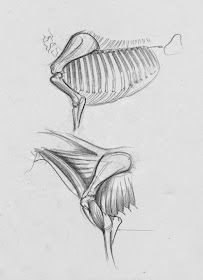There are approximately 205 bones in the horse's skeleton and the artist must understand the skeletal structure.
Shown below, is a drawing of the horse's superficial muscles with some of the main muscles identified.
Neck and shoulder: 1. Deltoid Back and trunk: 10. Latissimus Dorsi
2. Triceps 11. Longissimus
3. Brachiocephalus 12. Fascia of Back and Loins
4. Splenius 13. Ventral part of Serratus
5. Trapezius 14. Intercostals
6. Cervical Part of Serratus 15. External Abdominal
7. Sternocephalicus Obliques
8. Trapezius 16. Ascending Pectoral
9. Pectoral
Hindquarters: 17. Tensor Fascia Latae
18. Gluteals
19. Biceps
20. Hamstrings
21. Hamstrings
Although tissue, skin, and hair cover these muscles, they influence form.
The very nature of the horse's coat breaks reflections so that muscle masses become soft
and fused into one another. The artist must know what lies underneath. . .
In other words: What causes the bumps, bulges, and hollows that I see on the animal?
In other words: What causes the bumps, bulges, and hollows that I see on the animal?
I have sketchbooks full of bone structure and musculature drawings of many animals including the horse.
I have found that drawing the skeleton and superficial muscles is an extraordinary way to analyze physical
construction while a sculpture is in progress. . . much better than looking at pictures.
Keep in mind, drawing the animal from life allows the artist to portray the true character of the animal.
Keep in mind, drawing the animal from life allows the artist to portray the true character of the animal.
I constantly refer to the authors, illustrators, and publications
that are posted in the previous two blogs for anatomical information.
Below, are images of a great source of information . . . a plastic horse that I use in my studio for reference.
Contact Breyer Animal Creations - copyright, Susan L. Harris 2005
Go to the BLOG INDEX and Reference Page for more information.
Blog, text, photos, and sculpture . . . © Sandy Scott and Trish







No comments:
Post a Comment